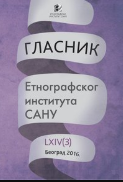The Wedding Act in Serbia in the Light of Social Changes - A Study of Traditional and Contemporary Ceremony
The Wedding Act in Serbia in the Light of Social Changes - A Study of Traditional and Contemporary Ceremony
Author(s): Aleksandra PavićevićSubject(s): Christian Theology and Religion, Customs / Folklore, Recent History (1900 till today), Cultural Anthropology / Ethnology, 19th Century, History of Communism, Social Norms / Social Control
Published by: Етнографски институт САНУ
Keywords: wedding; church; tradition; continuity; transformation;
Summary/Abstract: Re-traditional form of getting married included a wedding ceremony in which we had, among other rituals, an obligatory church wedding. The church wedding was omitted in certain cases, as, for example, the marriage of underage partners. When transformation of traditional life began, church wedding was omitted more often, though it was still the norm (in traditional and civilian law). In this period, traditional wedding ceremony was considered as popular way of marking the start of a new family. At the end of 19th and beginning of 20th century, the civil marriage ceremony was introduced, but most of couples still got married in church. This was the custom until The Second World War, when the church form of wedding became undesirable. Communist ideology meant a complete break with religious and national traditions. This resulted reduction of the numbers of church weddings, but not their complete omission. Economic crises, war destructions, low life standards and disturbance of the system of values, at the end of 20th century resulted in retraditionalisation processes as for instance, revitalization of church life, or some of it’s elements. Last few years in Serbia, young couples approach both the civilian marriage because it is an obligation and the church marriage — because of different reasons: need to make continuity with historical heritage, or to invent new one. I will try to show this course of transformation of act of getting married, through analyses of social meaning of some wedding ceremony elements.
Journal: Гласник Етнографског института САНУ
- Issue Year: LI/2003
- Issue No: 1
- Page Range: 79-86
- Page Count: 8
- Language: English

